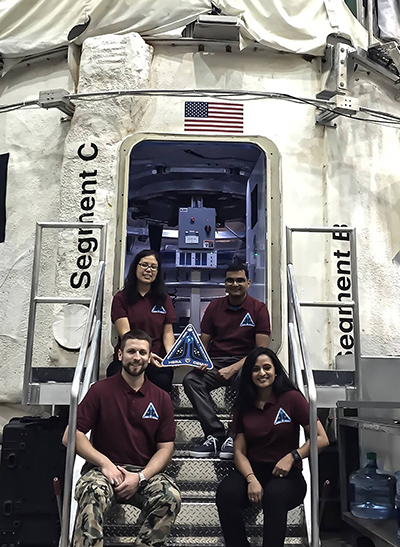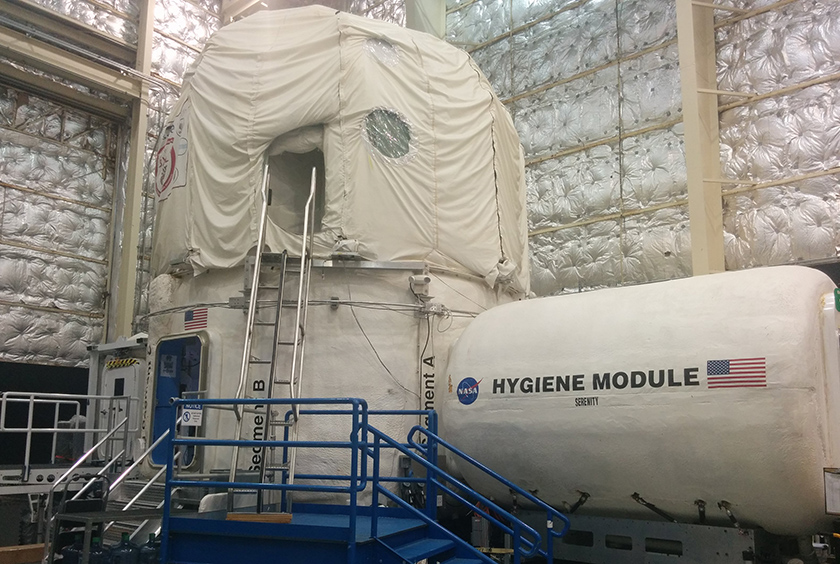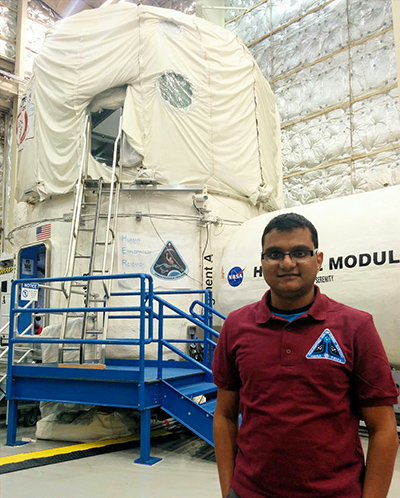HHP Student Completes 14 day Mission on NASA's Human Exploration Research Analog
(HHP doctoral student Rahul Goel just completed a 14 day mission as part of a 4 person crew on the Human Exploration Research Analog, a three-story, four-port habitat unit that simulates life in space, narrated here in his own words are his experiences on the mission.)
The Human Exploration Research Analog (HERA), formerly known as the Deep Space Habitat, is a three story habitat (approx. 47 feet across and 25 feet in height) at NASA JSC. It provides a high-fidelity research venue for scientists to address risks and gaps associated with human performance during spaceflight. The habitat is operated by the Flights Analog Division of Human Research Program at NASA JSC. The primary goal of the studies conducted at HERA is to evaluate how people will respond to isolation and confinement during typical mission exploration scenarios.

The 4 person crew for C2M4 (Campaign 2 Mission 4) on HERA
C2M4 (Campaign 2 Mission 4) was a 14-day mission (the first campaign in 2014 had four 7-day missions) of HERA. During the third campaign next year, mission duration will extend to 45 days. NASA selected a crew of four (two males and two females), from “astronaut-like” candidates from NASA’s test subject facility. In order to be eligible to participate, interested candidates had to pass the Air Force Class III equivalent physical exams and psychological tests. Each of the four crew members performed the same tasks during study duration. However each member was assigned a different position (commander, flight engineer, mission specialist 1 and 2), as one would expect for a typical space mission. I was the flight engineer on this mission.
As the expedition unfolded, it was interesting to see how people take on new and unexpected roles over and above their primary duties. One becomes a cook, electrician, mechanic, botanist, geologist, biologist, robotics expert and other specialties as needed, all in a day. We were assigned to a MCC (Mission Control Center) that provided technical and logistical support via voice or text loops 24/7. Additionally, on four of those 14 days there was a communication delay (5 minutes one-way on two days, and 10 minutes on the other two days) to mimic distant space travel. There was no face to face communication with anyone outside the habitat. Except the times when our family or friends could call or we had our private medical and psych conferences, once every week for about half an hour.

The Human Exploration Research Analog (HERA)
The HERA mission was simulating a possible future space mission in which astronauts will conduct a geological survey of an asteroid. An outbound transit which in reality may take ~370 days was simulated over the first six days, asteroid proximity operations which in reality may take ~20 days were simulated over the following four days, and the return transit was simulated over the last four days. Mission success depended on our ability to live and work with our crewmates during this long journey to achieve all mission objectives. During “transit”, we used on-board training systems to prepare for simulated excursions to the asteroid’s surface. We participated in scientific research in the areas of spaceflight psychology, physiology and human factors/habitability. We performed multiple system maintenance tasks of our “vehicle” and also worked on a few education and outreach payloads. During one of those nights, we were not allowed to sleep, simulating an encounter with comet debris field, which required us to keep a watch on “vehicle” status throughout the night.

Rahul Goel
Each activity of the mission was pre-planned and scheduled. We would wake up at 0700 and then spend the next approx. 1.5 hours on post-sleep activities including breakfast. Then we had a morning daily planning conference with the MCC to review the activities of the day. Various operational activities, science experiments and other tests took nearly 6.5hrs of a typical work day. Nearly 1.5 hours were set aside for exercise and personal hygiene. In the evening we could have a downtime of around 2 hours to have dinner, and do other fun activities like watching movies or playing cards. Some of the surveys and tests were scheduled right before going to bed at 2300 to simulate a full and busy day. There were also some unplanned anomalies in systems’ status such as a sudden increase in radiation level simulating a possible solar storm.
On some of the days we used a flight simulator to fly the multi-mission space exploration vehicle (MMSEV) to the asteroid’s surface, locating different sites of geological interest and to position the MMSEV to collect samples. We used a microscope to correctly identify and classify asteroid samples, assembled two robots and tested various proximity sensing technologies used in robotic spacecraft, performed shrimp brining, seed and crystal growth experiments that are typical for an exploration class mission, collected bio samples from crewmembers and habitat surfaces for microbial analyses, and conducted drills to simulate the treatment of medical symptoms and response to vehicle emergencies.
Throughout the mission we carried out a variety of alertness and mental tests to assess behavioral health and performance. We used the real time neurocognitive assessment toolkit for fatigue, optical computer recognition of stress and fatigue, audio and video recordings to dynamically monitor cognitive, emotional, and social mechanisms that influence performance. We monitored different parameters in response to stress like heart rate, blood pressure and collected saliva and blood at different time points during our mission. Apart from these there were several tasks to measure, maintain and regulate team role and cohesion.

Level 1 of HERA
When isolated from the rest of the world in a place that, even in simulation seemed surprisingly alien, preparing and eating food were the most communal and humanizing of domestic rituals. It served to maintain group cohesiveness and foster teamwork. We ate freeze dried vacuum sealed food from the same lab that prepares food for the astronauts. We had to rehydrate it and let it sit for few minutes to be ready to eat. There was always more food than we could eat. We also had to track our food intake using an app that is being considered for use by astronauts on the ISS.
As our mission was approaching its end, suddenly the leisure of the first few days gave way to rush. Two weeks seems like a long time, but the days went by too soon. If our own crew found frustration sometimes in so short a stay, I can hardly imagine what it would be like to travel for a year, one way to an asteroid in a cramped spacecraft. Be it on an asteroid or inside HERA one must learn to adjust to situations and compromise. The best ideas are not always partnered with the best resources, and vice versa. One must learn to adapt to anomalous situations and unexpected turns. Even when everything is well planned and luck seems to be with you, one aberrant incident or unexpected element can turn a teacher into a student, or a triumphant crew into a crew that is only dust in the wind.

Level 2 of HERA
An overarching aspect of the HERA experience was the simulation: How well can we function in a confined and isolated environment? What kinds of special problems will we encounter? How can we adapt to a different set of rules and protocols than those experienced on Earth? What personal qualities contribute to success and which ones could be detrimental? I am glad to say that our crew strictly followed the simulation and I think that was the most satisfying fact of the whole mission.
To conclude, rather than the end of a mission this seems like the beginning of an exciting journey. I hope that more people become aware of ground analogs like HERA and that the knowledge gained from these missions will help to build a real vision of a very new way of life that will take us into tomorrow.
- Rahul Goel